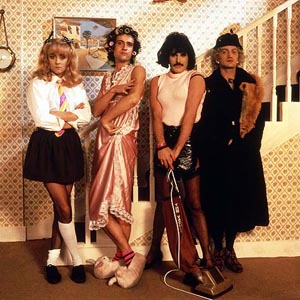Artist - Queen
Song Title - I Want To Break Free
Year - 1984
Genre - Rock
Director - David MalletThe next video I will look at is Queen's "I Want to Break Free", a very famous video that was released in April 1984.
One of the main reasons this song is so famous is because of it's music video, an example of how effective a music video can be, and how much good it can do for a song or band. For this video, the band members dressed in women's clothes, parodying the long-running, award-winning British Soap Opera, Coronation Street.
Whilst the video was well received in the UK, it was deemed controversial in America and banned by MTV and other stations. This shows the importance of understanding the audience you are aiming your video at, and understanding what they will see as acceptable.
The song was influenced by male's attitudes to the women's liberal movement. The idea behind the song and key theme throughout follows the title of the song.
 The opening shot of the video is of the rooftops of houses. The shot is very similar to shots in the opening credits of Coronation Streets, and looks like shots that would normally be associated with the program. Freddie Mercury's character in the video is loosely based on Bet Lynch, an iconic figure from the Soap. Mercury's character is wanting to "Break Free" throughout the video. As well as this, Roger Taylor, Brian May and John Deacon also represent characters from the program in Suzie Birchall, Hilda Ogden and Ena Sharples respectively.
The opening shot of the video is of the rooftops of houses. The shot is very similar to shots in the opening credits of Coronation Streets, and looks like shots that would normally be associated with the program. Freddie Mercury's character in the video is loosely based on Bet Lynch, an iconic figure from the Soap. Mercury's character is wanting to "Break Free" throughout the video. As well as this, Roger Taylor, Brian May and John Deacon also represent characters from the program in Suzie Birchall, Hilda Ogden and Ena Sharples respectively.Throughout the video, lip-synching is used. The visuals follow the general gist of the lyrics, generally following the theme of wanting to "Break free".
The group do also perform as themselves in the second part of the video. During this part, the band are set up in the same pattern as in the video, Bohemian Rhapsody, showing that bands use ideas more than once and occasionally have links between their music videos.
The genre that this song belongs to is Rock. In musical terms, Rock is often centered around the electric guitar as part of a band with a bass guitar and drums as well. As you can hear in the song, this fits the genre.
The reported budget for this song was £100,000, a large sum of money considering the time the video was made (1984). It shows the significance and the amount of money that music videos could make at that time.
The video is, in the main, a narrative based video. However, with the amount of lip-synching and singing to camera in the video, there are aspects of performance to the video. The majority is narrative though, and tells the story of a character trying to break free, linking in with the words from the title of the song.
The main things that I will take from this video are:
- The video parodies a very popular Television Program.
- The video also takes inspiration from other media platforms for characters and ideas for the video.
- The majority of the video follows closely to the title of the song, and the title sets a theme for the video.
- Bands can sometimes use similar ideas from video to video.
- Understanding your audience is key for the success of a music video.
Below is the video, "I Want to Break Free" By Queen.

Good post.
ReplyDeleteThink about theory/ists - you hint at it, but why might Stuart Hall be relevant when it comes to the point about Corrie + the very different US/UK aud reactions?
There's more to the vid as well - an opera-style sequence; we see the 2 sides of Mercury here: popular and high culture.
The rep'n of sexuality (Judith Butler/gender...) was notably more controversial in the US. A gay rock singer subverts the norms and expectations, just as Rob Halford (also long in the closet) did with Judas priest.